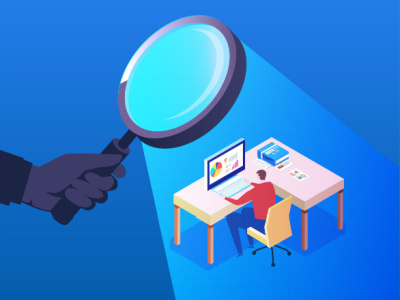Many workplace concerns arose during the COVID-19 pandemic or were preexisting but were exacerbated by it. One such issue is employee monitoring. Employers normally monitor employees extensively—timekeeping, project billing, performance evaluations, etc.—but the explosion of remote work during the pandemic created a lucrative market for more extensive monitoring processes.
Monitoring Basics
Monitoring can take a number of forms—from increased project oversight to geotagging, attention productivity measures (tracks speed, screen activity, and if you navigate away from certain things on your screen) to screen mirroring (the remote screen is mirrored onto another screen or another system) as well as a wide array of other processes and technologies. Some employers also reported greater use of other long-standing processes such as video monitoring and reviewing customer calls.
Internal public relations and risk mitigation go hand in hand. You cannot research the monitoring of employees without running into many articles on how employees feel about monitoring. If you want a summary of a few thousand articles—employees don’t like it very much.
Big Picture
You must balance the disconnect between the need to monitor work and the employees’ dislike and sometimes active disdain for the “rules.” When employees don’t understand or agree with the “why,” it can frequently lead to employee “workarounds” to escape the process. For every piece of technology, someone will create a hack. To bridge that gap and disincentivize workarounds, follow these best practices.
Understand why you are monitoring. Don’t set up a system without clearly understanding what you want from it. You can get software that tells you if an employee is away from the screen for more than 30 seconds, but what are you going to do with that data? Discipline? Terminate?
There are a lot of good reasons to monitor. To ensure client confidentiality, you monitor access. To ensure employee safety, you might geotag and provide other means to meet your Occupational Safety and Health Administration (OSHA) obligations, for instance, to assist with safety in remote locations including customer homes for service industries such as telecommunications and home health. You might have video monitoring to guard against theft or have other processes specific to your industry or company. Know why you want to monitor and what you will do with the data. It’s also critical to consider what success looks like. If you don’t know what success is, you can’t always measure failure.
Have a plan for data storage, retention, and use. Once you collect data, someone is going to want to look at it. Horror stories about screen mirroring capturing personal data—such as bank account information that is then accessed by other employees—abound, all of which create a significant privacy issue. If you video the parking lot and there’s an accident, someone will want a copy. Will you provide that to the public? Law enforcement?
Remember, if you are a public entity, this type of data is, in many instances, a public record. How will you store the data? How long will you keep it? The collection of data can quickly outstrip your storage capacity. However, if the data are used in a termination, or there’s a video of an accident or assault or something similar, you will need a method to preserve the data for an appropriate amount of time to mitigate litigation issues. If you use biometrics, depending on your state, very specific rules apply to its collection, use, and storage as well as its destruction.
Provide notice. Is what you are collecting legal? In Iowa, one party must consent to things such as audio recording. Almost everyone has had the customer service call experience that begins with the notice, “this call may be monitored for quality.” Other forms of monitoring such as keystroke logging don’t require consent. Employers are on less complicated legal grounds if employees know the nature and type of monitoring, employer expectations, and have signed an acknowledgment. Be clear, be specific, and provide notice to employees and customers to avoid issues in a rapidly evolving area.
Jo Ellen Whitney is an attorney with Dentons Davis Brown in Des Moines. You can reach her at joellen.whitney@dentons.com.

